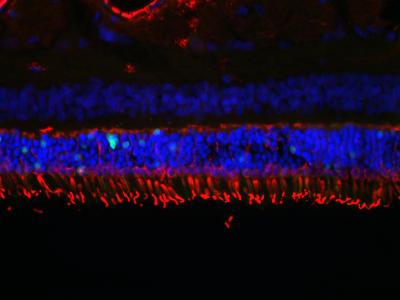
A mutation in the NPHP5 gene leads to a severe blinding disorder, Leber congenital amaurosis. Dogs with the condition that were treated with a gene therapy regrew normal, functional cone cells, labeled in red, that had previously failed to develop. The treatment led to a recovery of retinal function and vision. Image: Courtesy of Gustavo Aguirre and William Beltran
Gustavo Aguirre and William Beltran, veterinary ophthalmologists and vision scientists at the University of Pennsylvania School of Veterinary Medicine, have studied a wide range of different retinal blinding disorders. But the one caused by mutations in the NPHP5 gene, leading to a form of Leber congenital amaurosis (LCA), is one of the most severe.
A nearly identical disease naturally occurs in dogs. In a new paper in the journal Molecular Therapy, Aguirre, Beltran, and colleagues at Penn and other institutions have demonstrated that a canine gene therapy can restore both normal structure and function to the retina's cone photoreceptor cells, which, in LCA patients, otherwise fail to develop normally. Delivering a normal copy of either the canine or human version of the NPHP5 gene restored vision in treated dogs.
LCA includes a wide range of inherited vision disorders characterized by blindness that strike in early childhood. The form of LCA associated with NPHP5 mutations is rare, affecting about 5,000 people worldwide. Known as a ciliopathy, it affects the cilia of cells of the retina. The cilia cells are antennalike structures on photoreceptor cells that translate the energy from light into visual signals.
In the NPHP5 disease, rod photoreceptor cells--those responsible for vision in low light--degenerate and progressively die early in the disease. Yet the cone photoreceptors, which enable color vision and, in the central retina, the perception of fine detail, while abnormal structurally, survive, albeit without function.
The work was funded by the National Eye Institute.
Read more at Penn Today